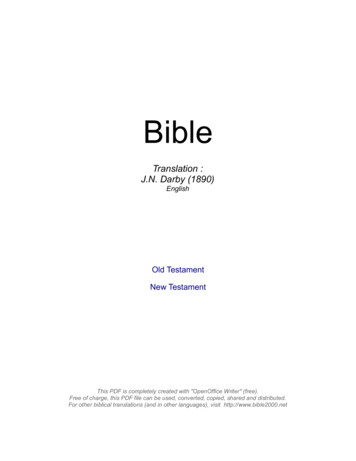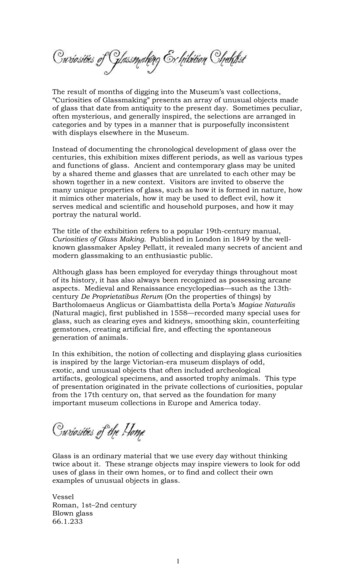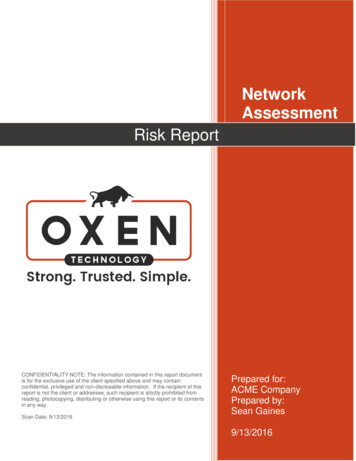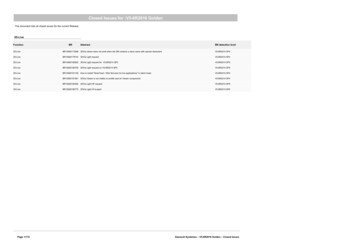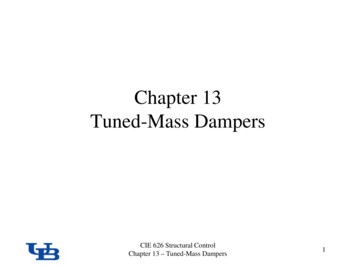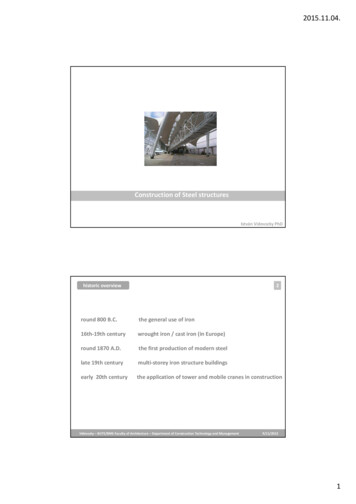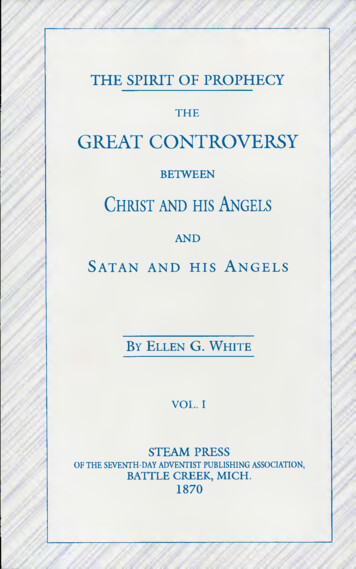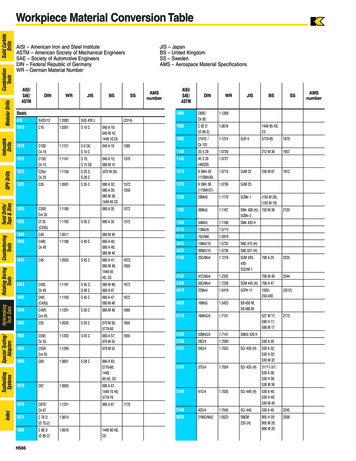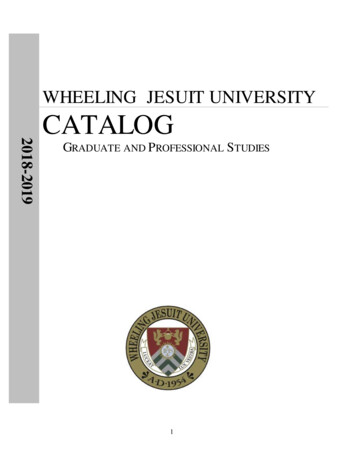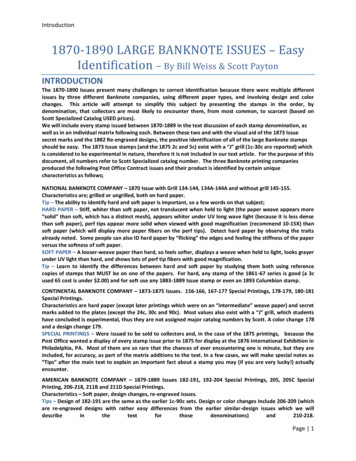
Transcription
Introduction1870-1890 LARGE BANKNOTE ISSUES – EasyIdentification – By Bill Weiss & Scott PaytonINTRODUCTIONThe 1870-1890 Issues present many challenges to correct identification because there were multiple differentissues by three different Banknote companies, using different paper types, and involving design and colorchanges. This article will attempt to simplify this subject by presenting the stamps in the order, bydenomination, that collectors are most likely to encounter them, from most common, to scarcest (based onScott Specialized Catalog USED prices).We will include every stamp issued between 1870-1889 in the text discussion of each stamp denomination, aswell as in an individual matrix following each. Between these two and with the visual aid of the 1873 Issuesecret marks and the 1882 Re-engraved designs, the positive identification of all of the large Banknote stampsshould be easy. The 1873 Issue stamps (and the 1875 2c and 5c) exist with a “J” grill (1c-30c are reported) whichis considered to be experimental in nature, therefore it is not included in our text article. For the purpose of thisdocument, all numbers refer to Scott Specialized catalog number. The three Banknote printing companiesproduced the following Post Office Contract issues and their product is identified by certain uniquecharacteristics as follows;NATIONAL BANKNOTE COMPANY – 1870 Issue with Grill 134-144, 134A-144A and without grill 145-155.Characteristics are; grilled or ungrilled, both on hard paper.Tip – The ability to identify hard and soft paper is important, so a few words on that subject;HARD PAPER – Stiff, whiter than soft paper, not translucent when held to light (the paper weave appears more“solid” than soft, which has a distinct mesh), appears whiter under UV long wave light (because it is less densethan soft paper), perf tips appear more solid when viewed with good magnification (recommend 10-15X) thansoft paper (which will display more paper fibers on the perf tips). Detect hard paper by observing the traitsalready noted. Some people can also ID hard paper by “flicking” the edges and feeling the stiffness of the paperversus the softness of soft paper.SOFT PAPER – A looser-weave paper than hard, so feels softer, displays a weave when held to light, looks grayerunder UV light than hard, and shows lots of perf tip fibers with good magnification.Tip – Learn to identify the differences between hard and soft paper by studying them both using referencecopies of stamps that MUST be on one of the papers. For hard, any stamp of the 1861-67 series is good (a 3cused 65 cost is under 2.00) and for soft use any 1883-1889 Issue stamp or even an 1893 Columbian stamp.CONTINENTAL BANKNOTE COMPANY – 1873-1875 Issues. 156-166, 167-177 Special Printings, 178-179, 180-181Special Printings.Characteristics are hard paper (except later printings which were on an “intermediate” weave paper) and secretmarks added to the plates (except the 24c, 30c and 90c). Most values also exist with a “J” grill, which studentshave concluded is experimental, thus they are not assigned major catalog numbers by Scott. A color change 178and a design change 179.SPECIAL PRINTINGS – Were issued to be sold to collectors and, in the case of the 1875 printings, because thePost Office wanted a display of every stamp issue prior to 1875 for display at the 1876 International Exhibition inPhiladelphia, PA. Most of them are so rare that the chances of ever encountering one is minute, but they areincluded, for accuracy, as part of the matrix additions to the text. In a few cases, we will make special notes as“Tips” after the main text to explain an important fact about a stamp you may (if you are very lucky!) actuallyencounter.AMERICAN BANKNOTE COMPANY – 1879-1889 Issues 182-191, 192-204 Special Printings, 205, 205C SpecialPrinting, 206-218, 211B and 211D Special Printings.Characteristics – Soft paper, design changes, re-engraved issues.Tips – Design of 182-191 are the same as the earlier 1c-90c sets. Design or color changes include 206-209 (whichare re-engraved designs with rather easy differences from the earlier similar-design issues which we 218.Page 1
Listings by DenominationLISTINGS BY DENOMINATION (Most common to scarcest)1c Values1. 1881 Re-engraved Issue 206; is identified by the strengthening of the background lines in the upper part of thedesign such that the area appears nearly solid;2. 1887 Issue 212; new design on soft, porous paper;3. 1879 Issue 182; on soft porous paper;4. 1873 Issue 156; on hard paper with secret mark (In the first pearl to the left of the numeral “1” there is a tinycrescent-shaped line);5. 1870 Issue without grill 145; on hard paper;6. 1870 Issue with “H” grill 134; on hard paper;7. 1870 Issue with “I” grill 134A;Tip – “I” grill is smaller than “H” grill, usually consisting of 10-11 vertical rows and 10-13 horizontal rows, while “H” grillsare usually larger 11-13 X 14-16 rows.8. Special Printings (see matrix).Scott er TypeHard White WoveHard White WoveHard White WoveHard White WoveHard White WoveHard White Wove - NGAISoft PorousSoft Porous – NGAISoft PorousSoft PorousSecret ear 00,000VERY RARE40COMMON590,000,000RARE388VERY COMMON 3,372,279,000VERY COMMON 1,325,000,0001c Mark Identifier - Line of Color in PearlImage Design: A44Image Design: A44aImage Design: A44b Re-engraved Comparison (Background Filled)Without MarkNot Re-engraved (A44 or A44a)With Secret MarkRe-engraved (A44b)Page 2
Listings by Denomination2c Values1. 1883 Issue 210; soft paper, new design;2. 1889 Issue 213; same design as 210 in new color (green);3. 1879 Issue 183; soft paper, same design as 1870-73 Issues but new color (vermilion);4. 1875 Issue 178; hard paper, same color and design as 183;5. 1870 Issue without grill 146; hard paper, color is light or reddish brown;6. 1873 Issue 157; hard paper, sometimes shows a secret mark (under the scroll to the left of “US” there is a smalldiagonal line. It seldom shows clearly, if at all, and Scott assigns a different value to it if it is without the secretmark). When the secret mark is not present, it can only be differentiated from the 1870 ungrilled issue by the color,which is always darker brown;Tip – This stamp is found on ribbed paper and actually is the value of the 1873 Issue that is most often seen withthis paper variety. Ribbed paper is considered unique to the 1873-75 Issues produced by Continental BanknoteCompany, even though a few copies have been reported on the 2c 1870 ungrilled stamp as well. Ribbed paper isdifficult for many collectors/dealers to see as it is only really visible by viewing the stamp across reflected light sothat the light is directed downward at the stamp which is held at a slight diagonal angle between your eyes and thelight. All of the values which exist on ribbed paper are a premium in Scott, which is why it pays to be able to identifyit. And the “grand prize” is the fact that the only reported copy of the 24c 1873 Issue 164 is on ribbed paper (seefurther discussion under 24c values).7. 1870 Issue with “H” Grill 135; on hard paper;8. 1870 Issue with “I” Grill 135A; hard paper;9. Special Printings.Tip – The Special Printing of the 1883 2c (211B, issued in 1885) may be encountered. It can be identified by aprinting difference which is not noted by catalogs, but is well-known to students. The cross-hatched designs locatedbetween the bottom of the bust at the left and the left oval vignette line extend all the way to the bottom of thatarea, whereas on the 1883 2c, the tiny crosshatch lines stop well up from the bottom of that area.Tip – the 2c 1880 Special Printing on soft paper 193 is easy to identify as it is the same design as the 2c 1870-73Issues but is on soft paper and the color is black brown. It is very rare, with only 416 copies reportedly issued. It isremotely possible that you might find one if you can easily identify soft paper.Scott 57GrillHINoNoJNoNoNoNoNoNoNoNoNoPaper TypeHard White WoveHard White WoveHard White WoveHard White WoveHard White WoveHard White Wove - NGAIYellowish WoveHard White Wove - NGAISoft PorousSoft Porous – NGAISoft Porous – NGAISoft PorousSoft PorousSoft PorousSecret MarkNoNoNoYesYesYesYesYesYesYesYesNoNoNoColorRed BrownRed BrownRed BrownBrownBrownDark BrownVermilionCarmine VermilionVermilionBlack BrownScarlet VermilionRed BrownPale Red icanAmericanAmericanAmericanAmericanAmericanYear 00,000UNCOMMON1,125,000VERY E416RARE917VERY COMMON 4,320,000,000VERY RARE55VERY COMMON 3,580,000,0002c Mark Identifier - Heavy line in underside of scroll, scroll completeImage Design: A45Image Design: A45aWithout MarkWith Secret MarkPage 3
Listings by Denomination3c Values1. 1882 Re-engraved Issue 207; soft paper, design is identified by the addition of a small horizontal dash below theright ribbon at bottom right and by the shading that projects from the oval around the center design being greatlyreduced in size from previous issues;2. 1873 Issue 158; identified by hard paper and addition of secret mark (shading in bottom left ribbon greatlydarkened);3. 1879 Issue 184; soft paper, same design as 1873 issue;4. 1870 Issue without grill 147; hard paper, no secret mark, color generally a lighter shade of green than 1873 issuewhich is usually found bluish green;5. 1870 Issue with “H” Grill 136;6. 1887 Issue (Scott 214); change of color ( vermilion);7. 1870 Issue with “I” Grill 136A;8. Special Printings (See Matrix).Scott per TypeHard White WoveHard White WoveHard White WoveHard White WoveHard White WoveHard White Wove - NGAISoft PorousSoft Porous – NGAISoft PorousSoft PorousSecret orGreenGreenGreenGreenGreenBlue GreenGreenBlue mericanAmericanYear AvailabilityUNCOMMONUNCOMMONVERY COMMONVERY COMMONUNCOMMONVERY RAREVERY COMMONRAREVERY 82,380,90015,000,0003c Mark Identifier - Shading under the left ribbon outer edgeImage Design: A46Image Design: A46aImage Design: A46b Re-engraved Comparison (Line under TS)Without MarkNot Re-engraved (A46 or A46a)With Secret MarkRe-engraved (A46b)Page 4
Listings by Denomination4c Values1. 1883 Issue 211; soft paper, blue green;2. 1887 Issue 215; color change, carmine;3. Special Printing 211D.Scott #211211D215DesignA58A58A58GrillNoNoNoPaper TypeSoft PorousSoft Porous – NGAISoft PorousSecret MarkNoNoNoColorBlue GreenDeep Blue GreenCarminePrinterAmericanAmericanAmericanYear NCOMMONQuantity*78,500,0001,02624,500,0005c Values1. 1882 Issue 205; New Design, Garfield, Yellow Brown;2. 1888 Issue 216; same, blue;3. 1879 Issue 185; same as 1875 new design, Taylor, soft paper;4. 1875 Issue 179; new design, Taylor, hard paper;5. 1882 Special Printing 205C.Scott GrillNoNoNoNoNoNoNoPaper TypeYellowish WoveHard White Wove - NGAISoft PorousSoft Porous – NGAISoft PorousSoft Porous – NGAISoft PorousSecret MarkNoNoNoNoNoNoNoColorBlueBright BlueBlueDark BlueYellow BrownGray ericanAmericanAmericanAmericanYear UNCOMMONRAREUNCOMMONRARECOMMONVERY ,351,0002285,000,0006c Values1. 1873 Issue 159; hard paper, secret mark (in bottom left ribbon design the first four vertical shading lines arestrengthened);Tip – This stamp can also, aside from the presence of the secret mark, usually be ID by the color, which is a lightershade than the 1870 issues.2. 1870 Issue Without Grill 148; hard paper, carmine, no secret mark;3. 1879 Issue 186; soft paper;4. 1882 Re-engraved Issue 208; soft paper; on the earlier 6c there are four vertical lines at the left outer designwhereas on the re-engraved there are three;5. 1870 Issue with “H” Grill 137;6. 1870 Issue with “I” Grill 137A;7. Special Printings (See matrix).Scott 47aA47aA47aA47aA47bGrillHINoNoJNoNoNoNoPaper TypeHard White WoveHard White WoveHard White WoveHard White WoveHard White WoveHard White Wove - NGAISoft PorousSoft Porous – NGAISoft PorousSecret rmineCarmineDull PinkDull PinkDull RosePinkDull ContinentalContinentalAmericanAmericanAmericanYear labilitySCARCESCARCEUNCOMMONUNCOMMONSCARCEVERY ge 5
Listings by Denomination6c Mark Identifier - Inside Left Ribbon Curl - 4 lines strengthenedImage Design: A47Image Design: A47aImage Design: A47b Re-engraved Comparison (3 lines vs 4)Without MarkNot Re-engraved (A47 or A47a)With Secret MarkRe-engraved (A47b)7c Values1. 1873 Issue 160; hard paper, secret mark (Two small semi-circles added at the indented lines at lower right corner);2. 1870 Issue Without Grill 149; hard paper, no secret mark;3. 1870 Issue With “H” Grill 138;4. 1870 Issue With “I” Grill 138A;5. Special Printings; Note that the 1880 7c Special Printing 196 is easy to identify because there is no othercorresponding 7c on soft paper.Scott aA48aGrillHINoNoJNoNoPaper TypeHard White WoveHard White WoveHard White WoveHard White WoveHard White WoveHard White Wove - NGAISoft Porous – NGAISecret lionVermilionVermilionReddish VermilionScarlet lContinentalContinentalAmericanYear SCARCESCARCEUNCOMMONUNCOMMONSCARCEVERY ,000704737c Mark Identifier - Curved Line in Lower Right GlobeImage Design: A48Image Design: A48aWithout MarkWith Secret MarkPage 6
Listings by Denomination10c Values1. 1882 Re-engraved Issue 209; soft paper, differs from the earlier 10c values by having only four vertical linesbetween the left side of the oval and the shield. There is also a layout dot located in the white oval directly acrossfrom Jefferson’s nose;2. 1873 Issue 161; hard paper, secret mark (tiny semi-circle added to the scroll at the right end of the upper label);3. 1870 Issue Without Grill 150; hard paper, no secret mark;4. 1879 Issue With Secret Mark 188; soft paper;5. 1879 Issue Without Secret Mark 187; soft paper;6. 1870 Issue With “H” Grill 139;7. 1870 Issue With “I” Grill 139A;8. Special Printings (see matrix).Scott er TypeHard White WoveHard White WoveHard White WoveHard White WoveHard White WoveHard White Wove - NGAISoft PorousSoft PorousSoft Porous – NGAISoft PorousSecret ownBrownBrownBrownPale BrownBrownBrownDeep ericanYear AvailabilitySCARCESCARCEUNCOMMONUNCOMMONSCARCEVERY 180146,500,00010c Mark Identifier - Line in Right Side ScrollImage Design: A49Image Design: A49aImage Design: A49b Re-engraved Comparison (4 lines vs 5, dot)Without MarkNot Re-engraved (A49 or A49a)With Secret MarkRe-engraved (A49b)Page 7
Listings by Denomination12c Values1. 1873 Issue 162; hard paper, secret mark (the left balls of the figure “2” are crescent shaped;2. 1870 Issue Without Grill 151; hard paper, no secret mark;3. 1870 Issue With “H” Grill 140;4. Special Printings; Note that 12c 1875 SP is easy to identify because there is no other corresponding 12c value onsoft paper;5. 1870 Issue With “I” Grill 140A.Scott aA50aGrillHINoNoJNoNoPaper TypeHard White WoveHard White WoveHard White WoveHard White WoveHard White WoveHard White Wove - NGAISoft Porous – NGAISecret MarkNoNoNoYesYesYesYesColorDull VioletDull VioletDull VioletBlackish VioletBlackish VioletDark VioletBlackish ntinentalContinentalAmericanYear SCARCELIMITEDUNCOMMONUNCOMMONSCARCEVERY 506028212c Mark Identifier - Ball of 2 in 12Image Design: A50Image Design: A50aWithout MarkWith Secret MarkPage 8
Listings by Denomination15c Values1. 1879 Issue 189; soft paper;2. 1873 Issue 163; hard paper, secret mark (note that the 15c secret mark is contentious, but catalogers describe it asthe lower part of the upper left triangle “V” is strengthened. It is our opinion that this stamp is best defined by thecolor shade, which is a darker orange than usually found on the 1870 Issues, and darker still if on ribbed paper);3. 1870 Issue Without Grill 152; hard paper, no secret mark, color is a lighter orange than the 1873 Issue;4. 1870 Issue With “H” Grill 141;5. 1870 Issue With “I” Grill 141A;6. Special Printings (see matrix).Scott A51aA51aA51aGrillHINoNoJNoNoNoPaper TypeHard White WoveHard White WoveHard White WoveHard White WoveHard White WoveHard White Wove - NGAISoft PorousSoft Porous – NGAISecret MarkNoNoNoYesYesYesYesYesColorOrangeOrangeBright OrangeYellow OrangeYellow OrangeBright OrangeRed ntalContinentalContinentalAmericanAmericanYear litySCARCESCARCEUNCOMMONUNCOMMONSCARCEVERY 0,00055,0003914,750,00016915c Mark Identifier - "V" in Upper Left Triangle (Faint in some cases)Image Design: A51Image Design: A51aWithout MarkWith Secret MarkNote also a wider "gap" between the lines of the A51 vs the A51aUnder magnification the A51 will always appear with a wider gap,and the visibility of faint lines in the right hand side of the triangleas opposed to the A51 which is almost entirely white space.Page 9
Listings by Denomination24c Values1. 1870 Issue Without Grill 153; hard paper;2. 1870 Issue With “H” Grill 142;3. Special Printings; note that the 1890 24c SP is easy to identify because there is no other corresponding 24c value onsoft paper;4. 1873 Issue 164; only one copy of this stamp is certified. It can only be identified because it is on vertically ribbedpaper which is considered to be unique to the Continental BNCo. While students believe Continental printed more24c stamps, as of now, there is no other way to differentiate them from National stamps except if on ribbed paper.Scott #14215
Tip – the 2c 1880 Special Printing on soft paper 193 is easy to identify as it is the same design as the 2c 1870-73 Issues but is on soft paper and the color is black brown. It is very rare, with only 416 copies reportedly issued. It is remotely possible that
